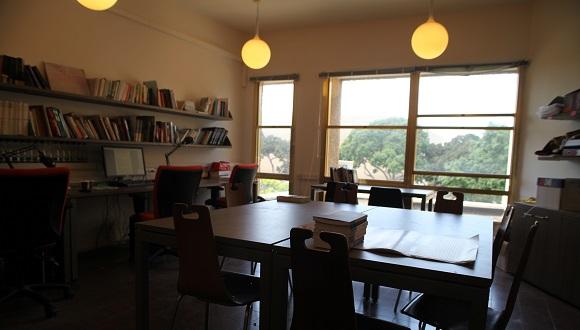מאמרים חדשים מאת חוקרות מרכז מינרבה
רויטל מדר, לינה ברוך, ורד סקאל, אריאל הנדל
מאמרים חדשים מאת רויטל מדר
אנחנו שמחים להודיע על פירסומם של שני מאמרים חדשים מאת רויטל מדר, תלמידת מחקר במרכז מינרבה למדעי הרוח:
מאמרה "Covered yet overexposed: From a female religious Jewish performance to Israel’s status as a western or non-western country" התפרסם באפריל 2015 בכתב העת International Journal of Fashion Studies, Volume 2, Number 1, 1 April 2015, pp. 115-120(6). קיראו את תקציר המאמרכאן.
מאמרה ""למתוח את מה שקיים": עבודתו של המעצב ששון קדם כמפגש אחר בין יצירה וביקורת" התפרסם ביוני 2015 בגליון מס. 2 של כתב העת בצלאל: כתב עת לתרבות חזותית וחומרית. קיראו את המאמר כאן.
*****
פרסומים חדשים מאת לינה ברוך
אנחנו שמחים לבשר על שלושה פרסומים חדשים מאת לינה ברוך, עמיתת מחקר במרכז מינרבה למדעי הרוח:
פירסומה של ארכאולוגיה של עתיד, אסופת שירים עבריים במקור ובתרגום לגרמנית, שערכה לינה ברוך יחד עם גדעון טיקוצקי:
Giddon Ticotsky und Lina Barouch (Hrsg.), Zukunftsarchäologie: Eine Anthologie hebräischer Gedichte. Frankfurt am Main: Klostermann, 2015.
פרטים נוספים על האסופה אפשר לקרוא באתר ההוצאה
ופרסומו של המאמר "הלדרלין בירושלים: בובר ושטראוס על שירה ועל גבולות הדיאלוג", שכתבה ברוך והתפרסם בגליון מיוחד של כתב העת נהריים על אריה לודוויג שטראוס, כמו גם הקדמה קצרה לגליון הזה, שכתבה ברוך יחד עם גלילי שחר:
Lina Barouch, "Hölderlin in Jerusalem: Buber and Strauss on Poetry and the Limits of Dialogue", Naharaim 2014, 8(2): 289–307
Lina Barouch and Galili Shahar, "Introduction: Arie Ludwig Strauss Between Hölderlin and Yehuda Halevi", Naharaim 2014, 8(2): 246-252
תקציר המאמר "הלדרלין בירושלים":
This paper discusses a series of commentaries and lyrical texts by Martin Buber and Ludwig Strauss, which dwell on Hölderlin’s poetry and the dialogical ideas implicit therein (e.g. the dialogical vocation of the poet). The paper distinguishes between the dialogical ideal and its concretization in language, as the selected texts all strive to develop a dialogical poetics, yet at the same time engage with textual junctures where the dialogical mode collapses. This collapse is also registered in the historical sphere: Buber’s engagement with Heidegger’s paradigmatic Hölderlin studies calls for a comparison with Strauss’s reception of Hölderlin, and therefore points to an absent dialogue between these two contemporary scholars. This historical lacuna, which Buber may have wished to bridge, thus resonates with ideas on the limits of dialogue in the poetic sphere. The paper draws on further Hölderlin scholars, such as Peter Szondi and Winfried Menninghaus, and their discussion of the lyrical results of failed dialogue, and on the ideas of Franz Rosenzweig and Rabbi Nahman, in the mapping of the dialogical ideas of both Buber and Strauss. Strauss himself thus emerges as a scholar and poet who draws both on Hölderlinian motifs and notions and on dialogical ideas in contemporaneous German-Jewish thought.
המאמר וההקדמה זמינים דרך אתר כתב העת
*****
מאמר חדש מאת ורד סקאל
אנחנו שמחים לבשר על פרסומו של מאמר חדש מאת ורד סקאל, עמיתת מחקר במרכז מינרבה למדעי הרוח:
Vered Sakal, "Realism, Pluralism, and Salvation: Reading Mordecai Kaplan through John Hick", The Journal of Jewish Thought and Philosophy, 23:1 (2015), 60-74.
תקציר המאמר:
The article surveys Kaplan’s ideas about God and salvation in the light of current debates on religious realism and pluralism. Using definitions formulated by John Hick, one of the prominent voices of religious realism and pluralism, the article’s central argument is that Kaplan was a religious realist who affirmed the ontological existence of God, even though his epistemology dictated the use of a nonrealistic and functionalistic religious language.
אל המאמר המלא אפשר לגשת דרך אתר כתב העת
*****
מאמר חדש מאת אריאל הנדל
אנחנו שמחים לבשר על פרסומו של מאמר חדש מאת אריאל הנדל, עמית מחקר במרכז מינרבה למדעי הרוח:
Ariel Handel, “Gated/Gating Community: The Settlement complex in the West Bank”, Transactions of the Institute of British Geographers 39 (2014), 504-517.
תקציר המאמר:
The claim that the settlements in the West Bank are gated communities might seem trivial. Those settlements are an explicit example of a community featuring, on the one hand, social cohesion based on shared values, while, on the other hand, self-isolation with the help of fences and a stress on the ‘security of the community’. The argument of this paper, however, is different. The paper suggests that the settlement layout in the West Bank is not just an aggregate of 124 ‘legal’ gated communities and a similar number of ‘illegal outposts’, but rather a single, contiguous gated community gating, in turn, Palestinian ‘islands’ within it. The reading I will offer seeks to look at the space in question through a careful reading of its use values. The emphasis is put on the question of mobilities in order to show how the fortressed points turn into an exclusionary web by means of separated roads and movement restrictions. By analysing the combined system of settlements, roads, military legislation, spatial design and applied violence, the paper shows how the few hundred points consolidate into one coherent spatial system.
The paper wishes to contribute to the spatial analysis of the now 45-year-old Israeli occupation of the West Bank, to the growing study of politics of mobility and to the discourse of gated communities by adding colonialism and violence to the mostly neoliberal explanations of the phenomenon.
אל המאמר המלא אפשר לגשת דרך אתר כתב העת
וראו גם העמוד של אריאל הנדל


